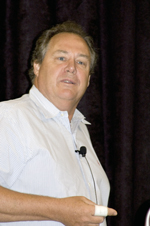General Session II
How the Next Generation of Genetic Technologies Will Impact Beef Cattle Selection
COLUMBIA, Mo. (June 30, 2010) — Looming on the horizon is a genomic revolution, according to University of Missouri geneticist Jerry Taylor. Addressing the 2010 Beef Improvement Federation (BIF) Research Symposium, in Columbia, Mo., Taylor said one of the most useful technology advances that is shaping the next generation of genetic evaluation is the availability of a genome sequence for beef cattle.
 Jerry TaylorTaylor said geneticists have known about single-nucleotide polymorphisms (SNPs) — points of variation in the DNA sequence responsible for expression and suppression of various traits — but they couldn’t use them until the genome sequence was known. The Illumina BovineSNP50, a 50,000 (50K) SNP genotyping assay has been useful in discovering SNP effects and initiating development of genomic-enhanced expected progeny difference (EPD) values without pedigree or progeny data. But the 50K assay has its limitations.
Jerry TaylorTaylor said geneticists have known about single-nucleotide polymorphisms (SNPs) — points of variation in the DNA sequence responsible for expression and suppression of various traits — but they couldn’t use them until the genome sequence was known. The Illumina BovineSNP50, a 50,000 (50K) SNP genotyping assay has been useful in discovering SNP effects and initiating development of genomic-enhanced expected progeny difference (EPD) values without pedigree or progeny data. But the 50K assay has its limitations.
“It takes a lot of genotyped animals within a breed to achieve high-accuracy EPDs, and they won’t work across breeds,” Taylor said. “Higher density assays can help us spot effects common to multiple breeds.”
Taylor said two 800,000 SNP assays are becoming available this year. Instead of spending years tracking one gene, high-density assays should allow many genes to be sorted out quickly. Additionally, next-generation sequencing platforms may allow scientists to figure out how chromosomes orient themselves within cells and determine which genes will be expressed. Other advancements should reveal why the expression of certain genes shared by two animals are expressed in one individual but suppressed in the other. Use of genotyping technology will likely become more affordable, too.
According to Taylor, development of all technologies follow a similar “hype curve.” Following discovery is a “peak of expectation” for advancements the technology could bring. Typically, research continues for a period with modest advancements, and the curve dips to a “trough of disillusionment.” Then, as breakthrough enhancements are made, the technology’s development enters a “slope of enlightenment,” followed by a “plateau of productivity” when the technology is put to practical use. Taylor predicted that practical application of genomic selection is near.
“It’s here, really, but we’re still trying to get accuracy up,” Taylor said. “We are climbing the slope of enlightenment.”
Editor’s Note: This summary was written under contract or by staff of Angus Productions Inc. (API). Through an agreement with the Beef Improvement Federation, we are encouraging reprinting of the articles to those who will adhere to the reprint guidelines available on this site. Please review those guidelines or contact Shauna Rose Hermel, editor, at 816-383-5270. PowerPoints are posted with permission of the presenter and may not be reproduced in whole or in part without the express permission of the presenter.
API's coverage of the event is made possible through collaboration with BIF and sponsorship by BioZyme Inc. through its significant gift to the Angus Foundation. For questions about this site, or to notify us of broken links, click here.
Headquartered in Saint Joseph, Mo., API publishes the Angus Journal, the Angus Beef Bulletin, the Angus Beef Bulletin EXTRA, and the Angus e-List, as well as providing online coverage of events and topics pertinent to cattlemen through the API Virtual Library.



